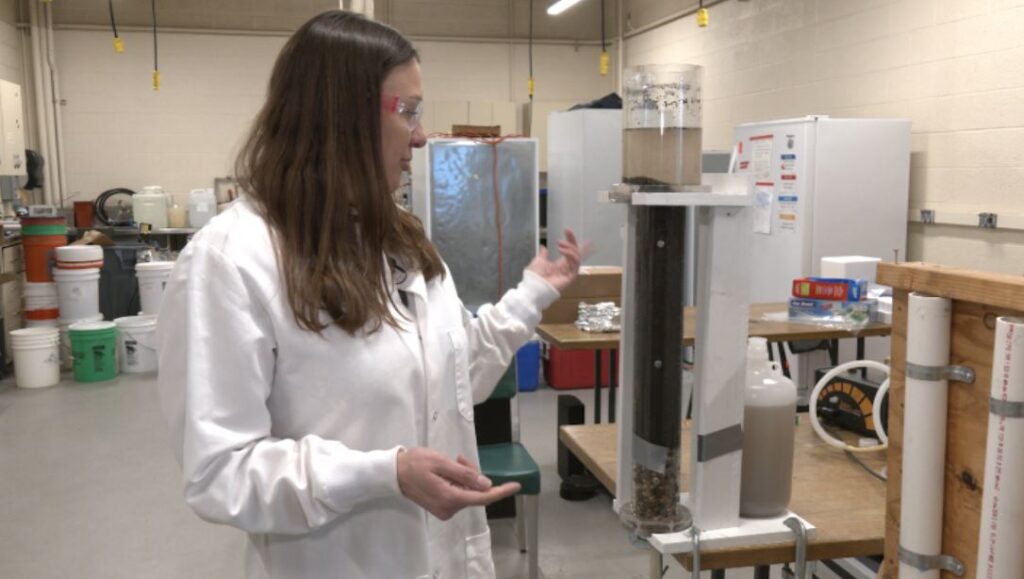Earth Month: NRRI’s Biochar research
Biochar is a material you may never have heard of, but its properties and potential are incredible.
It’s made from biomass, usually trees or agricultural waste, says Eric Singsaas, a research group leader at UMD’s Natural Resources Research Institute. It becomes Biochar when the waste is heated in a low- or oxygen-free environment. At the end of the process, it looks somewhat like charcoal or activated carbon.
One of Biochar’s main benefits is carbon sequestration.
“There’s too much carbon dioxide in the atmosphere right now,” Singsaas said. “Plants are made from carbon dioxide, right? If you look at most of a tree, all of that wood was once part of the air.”
Trees store CO2. When they are cut down or fall, they’re often either burned or left to decay. Either of those processes returns the carbon dioxide they previously stored to the atmosphere. But when they’re instead turned to Biochar, the carbon stays sequestered for anywhere from 10-10,000 years.
“So if it goes into a soil or into a building product or something like that, it becomes permanent or somewhat permanent,” Singsaas said.
NRRI researchers are looking into some of the many potential uses for Biochar.
Environmental chemist Bridget Ulrich is researching its uses related to stormwater.
“This is a bottle of water that I just collected from a puddle in the parking lot. As you can see, it’s dirty,” she said, gesturing toward a column in an NRRI lab. “I’m filtering the water through this column that contains a mixture of sand and Biochar. And you can tell that the water from the parking lot is substantially dirtier than the water that is coming out the other end of the filter.”

Ulrich says Biochar could be used as a filtering agent in rain gardens, for example. And right now, she’s working with the Lake County Soil and Water Conservation District to see if Biochar can help remove E. coli that’s been found in Agate Bay in Two Harbors.
“We’re working with them to select the Biochar that they’ll be putting into a new treatment system that will be installed this summer,” she said.
Chemistry and Materials Science Program Leader Brian Barry is studying Biochar as a cap for landfills. He’s using Balsam Fir that was removed from the Superior National Forest as part of fire mitigation efforts.
“For this project, we harvested the Balsam Fir, converted it to Biochar, and then we incorporated it into an engineered soil that’s used to cap a coal ash landfill out of one of Minnesota Power’s sites,” Barry said.
It’s helpful for capping landfills because the process of converting waste to Biochar also increases its porosity, improving the water-holding capacity of soils. That means it could also help stimulate growth on challenging farmland.
“It retains water,” Eric Singsaas said. “So when you have a poor soil like a sandy soil for a farm or garden, incorporating some Biochar or Biochar in compost can help soils retain moisture.”
There’s also research into how adding Biochar to concrete makes it cure faster and end up stronger.
“So understanding what different properties you want in Biochar to serve different markets and how to take different kinds of waste materials and process them to create these different properties is really the heart of our research program here,” Singsaas said.
Between the carbon sequestration and future uses, NRRI researchers see Biochar as an all-around win.
“No. 1, it’s got a great climate environmental story. It also creates an opportunity for things that were considered waste products otherwise, right?” Singsaas said. “And right now, the national forests, private forests have to pay to remove those fire hazard species anyway, so if they can essentially take something that they have to pay to do and then get some revenue from that, it helps really offset the cost of those fire reduction activities.”
“The end goal being that we can help the Forest Service have better managed forests,” Barry said.
“It’s really an all-around sustainable product,” Ulrich said. “It’s exciting that it’s a part of this circular economy where you’re not just treating water. You’re also offsetting carbon. And it can also be something that’s really regional and local.”
Read more about Biochar here or some of NRRI’s work with it here.